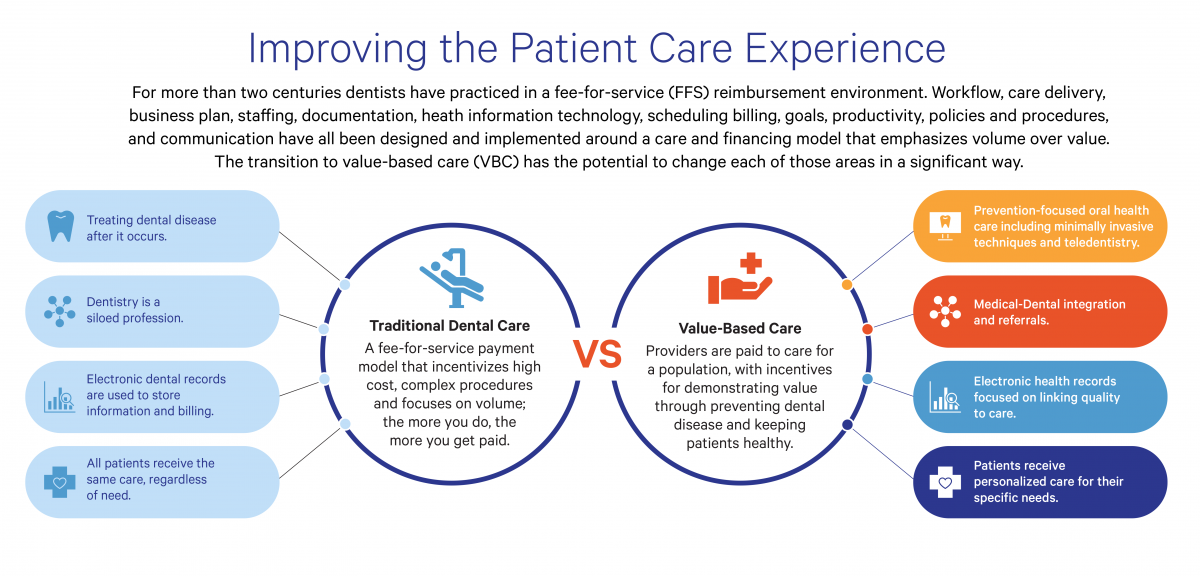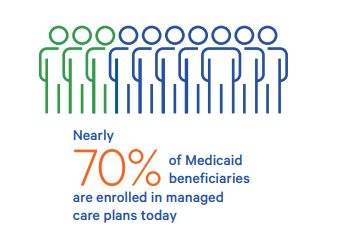Enter your email to receive the CareQuest newsletter:
October 18, 2021
The future of oral health is coming — and value-based care holds many of the keys to success.
For more than two centuries, dentists (and much of health care) have practiced in a fee-for-service model. The way dentists work and the system that surrounds them — workflows, care delivery, reimbursement, staffing, documentation, technology, and measurement — have all been designed to emphasize volume over value. Now, though, government regulations and a growing desire from all stakeholders to provide better, more personalized care for patients are driving change toward a new system.
In the next CareQuest Institute webinar, we’ll explore some of these dental processes and procedures that are ripe for change. We’ll also explore CareQuest Institute’s Three Domain Framework, which proposes a new model for dentistry and a case study of what a patient journey can look like when we prioritize value over volume.
What Is Value-Based Care?
Value-based care has many definitions. At its core, value-based care is a care delivery model in which providers are rewarded for quality health outcomes rather than the quantity of care delivered. And in this system, quality and outcomes should improve while costs remain the same (or fall). The reason? The healthier a person is, the fewer expensive (and often restorative and complicated) services they need.
Think of this simple equation: Outcomes + Quality
Cost
How do you measure quality? In 2001, now 20 years ago, the Institute of Medicine put forward a framework that is still in use today. The framework includes six aims for patient care:
- patient-centered
- equitable
- timely
- safe
- efficient
- effective
Measuring outcomes requires us to look longer and further into the future. This is particularly challenging for dentists and dental systems as providers are paid for the procedure they perform. Looking at outcomes requires a different perspective and longer buy-in — something that will require a shift in the system.
Improving the Care Experience
The goal, of course, is better patient care. When it comes to improving the overall care experience, value-based care revolves around providers who are paid to care for a population, with incentives for demonstrating value through preventing dental disease and keeping patients healthy. This graphic helps highlight the differences between traditional dental care and a value-based care model:

Value-based care prioritizes:
- prevention-focused oral health care including minimally invasive techniques and teledentistry
- medical-dental integration and referrals
- electronic health records focused on linking quality to care
- patients receiving personalized care for their specific needs
Value-based care models are designed to align the system of care, the person, the provider, and the community to achieve better health outcomes at lower costs. Successful designs are prevention-focused, minimally invasive, person-centered, and risk-based to ensure an equitable distribution of resources.
In value-based systems, medical care does not exist in silos. Instead, primary, specialty, and acute care are integrated. This team-oriented approach to patient care and sharing of patient data helps to coordinate care and makes it easier to measure outcomes.
Communication and coordination of care between oral health and other health care disciplines has long been an obstacle. This disconnect — the inability of health information systems to meaningfully collect, interpret, and share data — limits the system’s ability to address whole-person care across the lifespan. Dismantling silos is vitally important in the move toward value-based care — and, fortunately, something that recently received a boost with the publication of the first implementation guides to help bridge the communication gap between primary care and oral health care.
Access to electronic health data can help isolate specific geographic or population-based areas where individuals can benefit from enhanced care and social coordination efforts to provide more timely and effective interventions. Further, dental and medical providers have increased use of oral health risk assessments and are beginning to use targeted outreach and population health analytics in their practices.
Payment Transformation through Value-Based Care
As highlighted in the equation above, the “value” in value-based care is derived from measuring health outcomes against the cost of delivering care. And there’s a growing chorus in the industry who believe that fee-for-service is no longer the best method for revenue generation. The COVID-19 pandemic helped to underscore the reality that payments based upon value rather than the units and types of services delivered is more predictable and stable.
Therefore, payment design is an enabler for value-based care. But it’s a challenging transition to make, as the systems to truly measure cost of the care for a patient population are still incomplete. It’s also still a new concept for many in the oral health industry. According to a 2020 CareQuest Institute report, more than half (51%) of responding providers had never heard of alternative payment models (value-based care is a n example) in dentistry.
n example) in dentistry.
But in the same report, research highlighted that alternative payment models are increasingly being used both in Medicaid and Medicare and are even entering private insurance. Nearly 70% of Medicaid beneficiaries are enrolled in managed care plans today. And ongoing work in states like Michigan and New Hampshire is paving the way to make the transition to a value-based payment model.
Editor’s note: To learn more register for the October 21 webinar, “How Value-Based Care Will Change Dentistry’s Future.”